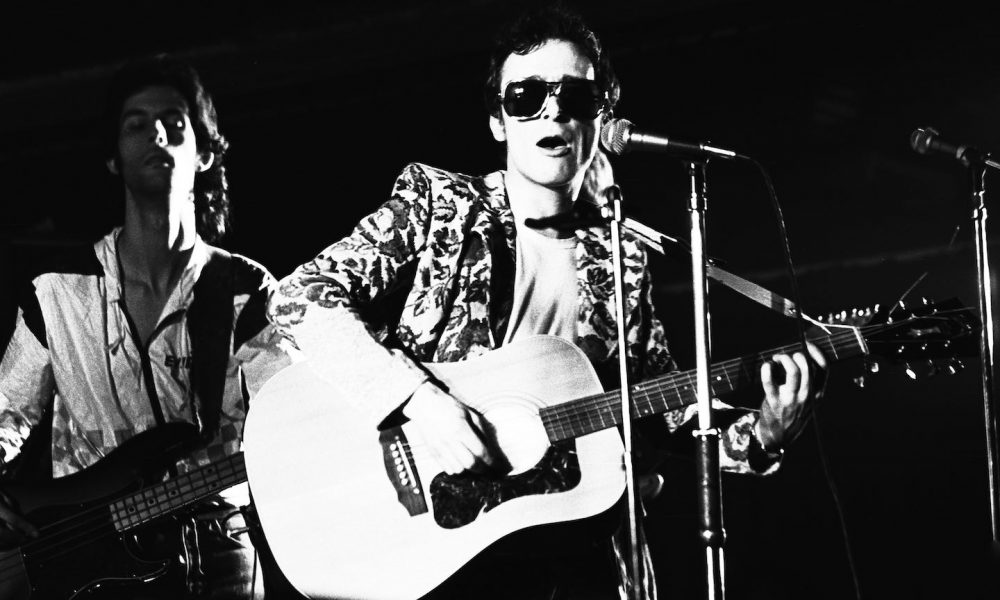‘Howlin’ Wind’: Graham Parker & The Rumour’s Storming Debut
The 1976 album didn’t chart, but it whipped up a storm of critical acclaim that paved the way for the follow-up of just six months later, ‘Heat Treatment.’

Graham Parker spent the first half of the 1970s performing all manner of day jobs and putting in the archetypal 10,000 hours to make it big. In the era when artists often spent years gazing in on the upper echelons of the music business in hope more than expectation, the soulful frontman and songwriter was more than ready for his breakthrough when his first album with The Rumour, Howlin’ Wind, was released under their new deal with Vertigo in the U.K. and Mercury in the U.S. in April 1976.
The LP didn’t make the chart in either country, but the storm of critical acclaim it whipped up paved the way for the group’s debut in the bestsellers, on both sides of the Atlantic, with the follow-up of just six months later, Heat Treatment. Such was the media embrace for their raw blend of rock and soul influences that when Village Voice published their annual Pazz & Jop critics’ poll at the end of that year, Parker and co had two of the top four, with Heat Treatment at No.2 (second only to Stevie Wonder’s unassailable Songs in the Key of Life) and Howlin’ Wind at No.4 (separated by Jackson Browne‘s The Pretender).
The band’s style, to some degree, grew out of the pub-rock sound of the earlier 1970s, blended with Parker’s R&B tendencies, and his years listening to Motown, Otis Redding, and ska. Moreover, several notables from one of the pub circuit’s most dependable contributors, the band Brinsley Schwarz, were intrinsic to Howlin’ Wind.
The guitarist who gave his name to the band was a member of The Rumour, as was their keyboard player Bob Andrews. Brinsley Schwarz’s lead singer Nick Lowe, soon to make his own name both as a solo artist and new wave producer, was at the desk at Eden Studios in London for the Parker record. Guests included Dave Edmunds, who added guitar to “Back To Schooldays,” which he then covered on his own 1977 album Get It.
Well before the release of Howlin’ Wind, it was clear that the frontman and the band were going places. New Musical Express’ Chas de Whalley wrote of their opening slot for Ace at Southampton University in the January: “When the swingtimed ‘Lady Doctor,’ the moody ‘Gypsy Blood’ and tour-de-force rockers ‘The Raid’ and ‘Soul Shoes’ were finished, I found myself with a rare feeling of almost total satisfaction.
“Parker’s songs are simple and precise, showing definite allegiance to the three-minute single and the golden years of the early Sixties. Off stage he’s a shy and unassuming person, but a man who puts everything he has into his music.”
Parker and his bandmates spent most of 1976 developing their reputation as a scintillating live attraction. At home, they did so both on the university circuit, including further support tours with Kokomo and Thin Lizzy, and at London venues that grew exponentially from the Marquee to Hammersmith Odeon. In America, they hit the circuit that summertime, including over two nights at New York’s Bottom Line in August.
In December 1976, NME reviewed Parker and the band again, this time in the opening slot at another New York nightspot, the Palladium, where Stephen Demorest observed: “Most of the press came to see Parker, most of the crowd came to see [Southside Johnny] from neighboring New Jersey, and most stayed to see [Robert] Palmer. Even before the show, many people thought that the billing should have been reversed.”
The following year at the the British Record Industry Britannia Awards – the first event of what became the BRIT Awards – Parker‘s arrival was complete when he was jointly named Most Promising Newcomer with singer-actress Julie Covington.
Two months after the release of Howlin’ Wind, Parker told Sounds of his no-holds-barred stage delivery: “I just want to hit it so that it’s strong. I’d like to be able to lay back but I find that very hard because I feel strongly about the words, having written them. I get very full of energy. It’s hard work. I don’t feel like it right now but I’ve got to do it when I get on stage. I want to shout it at people. I want them to feel gritty.
“I’ve always wanted a voice like I’ve got now and the songs I’ve got now so it’s quite a fulfilling thing to do it and see people affected by it,” he observed. “They listen to the lyrics and they know what I mean, not analyzing it, but they know the feeling.”
Listen to Howlin’ Wind on Apple Music and Spotify.












